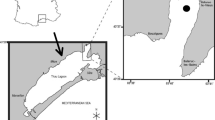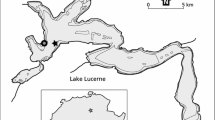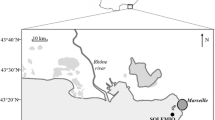Abstract
Water samples were collected in and near Kasitsna Bay (Cook Inlet), Alaska over 18 mo (February 1979–August 1980). Seasonal changes in glucose and glutamate uptake rates were measured in these samples. During the second year of the study, the uptake rates of glycolate and acetate and primary productivity were also measured. Of the substrates tested, significant positive linear correlations were observed between glucose and glutamate uptake and primary productivity. A higher correlation was observed between glucose to glutamate uptake ratios and primary productivity. The seasonal patterns of glucose uptake, glucose-to-glutamate uptake ratios and primary productivity rates show that the ratios changes simultaneously with fluctuations in primary productivity rates. The glucose uptake patterns reveal a delay in the response of the glucose-utilizing microorganisms to the onset of the bloom. It is suggested that by measuring the uptake rates of the simple compounds by microheterotrophs, and comparing these rates with each other, one can determine the relative flux of these compounds through the system. If the major source of these compounds is material released into the seawater by phytoplankton, it is possible that this approach could characterize the flux of extracellular products. As more is known about how the composition of extracellular material relates to the physiological state of phytoplankton, such an approach may eventually be a useful indirect assessment of the physiological state of natural phytoplankton populations.
Similar content being viewed by others
Literature Cited
Albright, L. J.: Heterotrophic bacterial dynamics in the lower Fraser River, its estuary and Georgia Strait, British Columbia, Canada. Mar. Biol. 39, 203–211 (1977)
Andrews, P. and P. J. LeB. Williams: Heterotrophic utilization of dissolved organic compounds in the sea. III. Measurement of the oxidation rate and concentration of glucose and amino acids in seawater. J. mar. biol. Ass. U.K. 51, 111–125 (1971)
Bell, W. H. and E. Sakshaug: Bacterial utilization of algal extracellular products. 2. A kinetic study of natural populations. Limnol. Oceanogr. 25, 1021–1033 (1980)
Bent, E. J. and R. Goulder: Planktonic bacteria in the Humber Estuary; seasonal variation in population density and heterotrophic activity. Mar. Biol. 62, 35–45 (1981)
Billen, G., C. Joiris, J. Wijnant and G. Gillain: Concentration and microbiological utilization of small organic molecules in the Scheldt Estuary, the Belgian coastal zone of the North Sea and the English Cannel. Estuar. cstl mar. Sci. 11, 279–294 (1980)
Delattre, J. M., R. Delesmont, M. Clabaux, C. Oger and H. Leclerc: Bacterial biomass, production and heterotrophic activity of the coastal seawater at Gravelines (France). Oceanol. Acta 2, 317–324 (1979)
Fogg, G. E.: The extracellular products of algae. Oceanogr. mar. Biol. A. Rev. 4, 195–212 (1966)
Fogg, G. E., C. Nalewajko and W. D. Watt: Extracellular products of phytoplankton photosynthesis. Proc. R. Soc. (Ser. B) 162, 517–530 (1965)
Fuhrman, J. A., J. W. Ammerman and F. Azam: Bacterioplankton in the coastal euphotic zone: distribution, activity and possible relationships with phytoplankton. Mar. Biol. 60, 201–207 (1980)
Gillespie, P. A., R. Y. Morita and L. P. Jones: The heterotrophic activity for amino acids, glucose and acetate in Antartic waters. J. oceanogr. Soc. Japan. 32, 74–82 (1976)
Griffiths, R. P., S. S. Hayasaka, T. M. McNamara and R. Y. Morita: Comparison between two methods of assaying relative microbial activity in marine environments. Appl. envirl Microbiol. 34, 801–805 (1977)
Griffiths, R. P., S. S. Hayasaka, T. M. McNamara and R. Y. Morita: Relative microbial activity and bacterial concentrations in water and sediment samples taken in the Beaufort Sea. Can. J. Microbiol. 24, 1217–1226 (1978)
Hanson, R. B. and J. Snyder: Microheterotrophic activity in a salt-marsh estuary, Sapelo Island, Georgia. Ecology 60, 99–107 (1979)
Hanson, R. B. and J. Snyder: Glucose exchanges in a salt marshestuary: biological activity and chemical measurements. Limnol. Oceanogr. 25, 633–642 (1980)
Hellebust, J. A.: Excretion of some organic compounds by marine phytoplankton. Limnol. Oceanogr. 10, 192–206 (1965)
Herbst, V. and J. Overbeck: Metabolic coupling between the alga Oscillatoria redekei and accompanying bacteria. Naturwissenschaften 65, 598–599 (1978)
Hobbie, J. E. and P. Rublee: Radioisotope studies of heterotrophic bacteria in aquatic ecosystems. In: Aquatic microbial communities, pp 441–476. Ed. by J. Cairns, Jr.: New York: Garland Publishers 1977
Jolley, E. T. and A. K. Jones: The interaction between Navicula muralis Grünow and an associated species of Flavobacterium. Br. phycol. J. 12, 315–328 (1977)
Lancelot, C.: Gross excretion rates of natural marine phytoplankton and heterotrophic uptake of excreted products in the southern North Sea, as determined by short-term kinetics. Mar. Ecol. Prog. Ser. 1, 179–186 (1979)
Larrence, J. D.: Phytoplankton and primary productivity in the northeastern Gulf of Alaska and Lower Cook Inlet. In: Environmental assessment of the Alaskan continental shelf, Vol. 10. pp 1–136. Juneau, Alaska: Office of Marine Pollution Assessment, National Oceanic and Atmospheric Administration, U.S. Department of Commerce 1977
Larsson, U. and A. Hagström: Phytoplankton exudate release as an energy source for the growth of pelagic bacteria. Mar. Biol. 52, 199–206 (1979)
Lelong, P. P., M. A. Bianchi et Y. P. Martin: Dynamique des populations planctoniques et bacteriennes au cours d'une production experimentale de phytoplancton marin naturel. II. Structure et physiologie des populations et leurs interactions. Can. J. Microbiol. 26, 297–307 (1980)
Mague, T. H., E. Friberg, D. J. Hughes and I. Morris: Extracellular release of carbon by marine phytoplankton; a physiological approach. Limnol. Oceanogr. 25, 262–279 (1980)
Merz, R. C., R. G. Zehnpfenning and J. R. Klima: Chromatographic assay of extracellular products of algal metabolism. J. Wat. Pollut. Control Fed. 34, 103–115 (1962)
Morita, R. Y. R. P. Griffths and S. S. Hayasaka: Heterotrophic activity of microorganisms in Antarctic waters. Proceedings of the 3rd SCAR Symposium on Antarctic biology, pp 99–113. Ed. by G. A. Llano. Houston: Gulf Publishing Co. 1977
Newell, R. C., M. I. Lucas and E. A. S. Linley: Rate of degradation and efficiency of conversion of phytoplankton debris by marine microorganisms. Mar. Ecol. Prog. Ser. 6, 123–136 (1981)
Rieper, M.: Investigations on the relationships between algal blooms and bacterial populations in the Schlei Fjord (western Baltic Sea). Helgoländer wiss. Meeresunters. 28, 1–18 (1976)
Shah, N. M. and R. T. Wright: The occurrence of glycolic acid in coastal sea water. Mar. Biol. 24, 121–124 (1974)
Sharp, J. H.: Excretion of organic matter by marine phytoplankton: do healthy cells do it? Limnol. Oceanogr. 22, 381–399 (1977)
Smith, D. F. and W. J. Wiebe: Constant release of photosynthate from marine phytoplankton. Appl. envirl Microbiol. 32, 75–79 (1976)
Smith, W. O., Jr., R. T. Barber and S. A. Huntsman: Primary production off the coast of northwest Africa: excretion of dissolved organic matter and its heterotrophic uptake. Deep-Sea Res. 24, 35–47 (1977)
Strickland, J. D. H. and T. R. Parsons: A practical handbook of seawater analysis, 2nd. ed. Bull. Fish. Res. Bd Can. 167, 1–310 (1972)
Vaccaro, R. F.: The response of natural microbial populations in seawater to organic enrichment. Limnol. Oceanogr. 14, 726–735 (1969)
Wiebe, W. J. and D. F. Smith: Direct measurement of dissolved organic carbon release by phytoplankton and incorporation by microheterotrophs. Mar. Biol. 42, 213–223 (1977)
Williams, P. J. LeB. and C. S. Yentsch: An examination of photosynthetic production, excretion of photosynthetic products, and heterotrophic utilization of dissolved organic compounds with reference to results from a coastal subtropical sea. Mar. Biol. 35, 31–40 (1976)
Wright, R. T. and J. E. Hobbie: Use of glucose and acetate by bacteria and algae in aquatic ecosystems. Ecology 47, 447–468 (1966)
Wright, R. T. and N. M. Shah: The trophic role of glycolic acid in coastal seawater. II. Seasonal changes in concentration and heterotrophic use in Ipswich Bay, Massachusetts, USA. Mar. Biol. 43, 257–263 (1977)
Author information
Authors and Affiliations
Additional information
Communicated by N. D. Holland, La Jolla
Published as Technical Paper No. 6397, Oregon Agricultural Experiment Station
Rights and permissions
About this article
Cite this article
Griffiths, R.P., Caldwell, B.A. & Morita, R.Y. Seasonal changes in microbial heterotrophic activity in subarctic marine waters as related to phytoplankton primary productivity. Mar. Biol. 71, 121–127 (1982). https://doi.org/10.1007/BF00394619
Accepted:
Issue Date:
DOI: https://doi.org/10.1007/BF00394619




